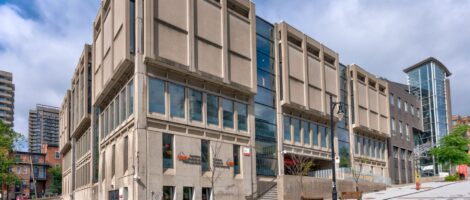October 14, 2022. By the Student Society of McGill University Executive (SSMU)
Students and community members have shared serious concerns about McGill’s New Vic Project. In response, SSMU has met with various stakeholders, including the University’s administration, to shed some light into McGill’s decision process. We leave here a summary of our discussions to break the alleged “culture of silence” around the issue.
McGill’s New Vic project is anchored within McGill’s master plan that concerns the physical development of the university at both of its campuses over the next decades. Indeed, the university intends to transform a part of the former Royal Victoria site into a new Pavilion of Sustainability Systems and Public Policy. This plan, formally endorsed by McGill’s Board of Governors in January 2019, recognizes the kanien’kehá:ka as the traditional stewards of the waters and land on which its campuses are located. Further, the plan calls for open dialogue and on-going consultation with Indigenous communities.
In October 2021, the kanien’kehá:ka kahnistensera, a group of mohawk mothers, published an article demanding an immediate halt of “ all reconstruction plans for the Royal Victoria Hospital and Allan Memorial Institute sites.” In this article, the kahnistensera, caretakers of thequenondah (two mountains/mount royal), explain that
- Since the site is on kanien’kehá:ka land, which has never been ceded, the kahnistensera are the only ones who can consent to any work being done;
- The whole site is of archeological interest as it holds the history of the original precolonial Iroquoian village;
Investigations of the grounds of the Allan Memorial Institute for potential unmarked graves resulting from the MK-Ultra program is necessary. - McGill, to our knowledge, has never addressed those demands publicly. In February, the kahnistensera took McGill to federal court over the matter, suing the university, the Société Québécoise des Infrastructures (SQI) and others.
When talking with McGill representatives, they added emphasis on the fact that the possibility of unmarked graves from the MK-Ultra experiments would be confined to the Allan Memorial. More specifically, McGill highlights that they own only 15% of the site at the corner of Pine and University, a part which is far away from the Allan Memorial Institute.
While Arkéos, the archeological firm hired by McGill, agrees that it is less likely that the alleged bodies related to the MK-Ultra program would be found in McGill’s part of the Royal Victoria, they affirm that the area is still of archeological interest. In truth, Arkéos seems to be in agreement with the kahnistensera about the presence of a precolonial Iroquoian village at the site. Only, Arkéos limits the areas of archeological interest to certain parts of the site on the basis of preliminary research they conducted in 2016. The mothers contest this account as thequenondah was densely populated by their ancestors. To be clear, the kahnistensera identify the Hersey Pavilion (where construction is set to start first) as an area of “high risk of containing both precolonial and modern graves of [their] relatives.”
In our various meetings with stakeholders of McGill University, and the SQI, land acknowledgments were given. However, as articulated in SSMU’s Equity and Indigenous Solidarity Policies, it is imperative to go beyond land acknowledgments, recognize and work to dismantle historic and ongoing systems of colonial oppression and marginalization. We hope the paragraphs below are able to paint an accurate portrait of the steps McGill has taken to try to address the needs of Indigenous Communities. At this time, it seems like those steps are insufficient, and that McGill has failed to address its role in the perpetuation of colonialism, prioritizing the efficient delivery of its expansion project over the necessary respect of the traditional laws and customs of the lands it occupies.
In talking with the various people involved, including Fabrice Labeau,Deputy Provost (Student Life and Learning), it has become evident that to this date, McGill has never met with the mohawk mothers outside of court. Despite the fact that the kahnistensera sent a Notice of Seizure to McGill University in 2015, that they requested a meeting with its president Suzanne Fortier numerous times, and that the University was sued both in Federal and Provincial court, an invitation to meet with the mothers was only extended recently. At this time, the invitation seems inconsiderate of the kahnistensera’s needs which are to have a meeting in Kahnawake open to everyone where the number of Indigenous people would surpass that of non-Indigenous. All of which is understandable given the violence of on-going and past colonial oppression.
In our conversations with Dicki Chhoyang, Director of Stakeholder Relations for the McGill Master Plan, she deplored the fact that this issue reached the court. In explaining their choice to go to court, the mothers have explained that they are obligated to do so under the Great Law of Peace, kaianerekowa, for their unborn children as protectors of the soil.
Through this process, McGill has talked with various stakeholders. When the allegations were first made, McGill invited Indigenous faculty and staff to discuss the issue. Their main demands, according to the university, was that the allegations be seriously investigated. To our knowledge, that investigation process is still happening in the courts.
Despite the on-going court case, where an injunction will be considered on October 26, the excavators paid by McGill were busy yesterday morning removing the asphalt in front of the Hersey Pavilion. While this part of the work is well underway, no archeologists or Indigenous Observers are on site.
Two observers are supposed to be present during the whole duration of the archeological survey. According to the administration, these observers, recommended by the Akwesasne Band Council, have experience in the field. While wanting to have Indigenous observers on site is commendable, it is not equivalent to Indigenous-led archeological research. It is worth noting that the latter is the recommendation of the Canadian Archeological association and the Truth and Reconciliation Commission.
This is troublesome to us. McGill should not be able to pick and choose how and when it applies the Truth and Reconciliation Commission of Canada. Moreover, when asking the archeological firm, Arkéos, whether they were able to meet with the kahnistensera, an Arkéos representative admitted that they had originally set a meeting that was, at the last minute, canceled by McGill and SQI. This raises the issue of the independence of the archeological firm. Indeed, their consultation process seems to have been limited by the University and Government society.
Per Quebec Law, since this is unfolding on the Mount-Royal, only the approval of the Band Council is necessary to start construction. McGill has explained that the Quebec Ministry of Culture has consulted the Kahnawake Band Council and received necessary permission. The University, in turn, has engaged with the Kahnawake Band Council as well as the Akwesasne Band Council.
McGill also claims to have presented the project to the Kahnawake LongHouses.Two elders from the Mohawk trail LongHouse have confirmed that they personally have been in conversation with McGill for the past year or so, that they have visited the site and performed a condolence ceremony.
McGill, the SQI and Arkéos have over the last week held information sessions about the archeological process to a variety of groups, including to the McGill student associations representatives, Indigenous members of faculty and staff and a few representatives from the Handsome Lake Akwesasne LongHouse and the Mohawk Trail LongHouse.
When asked about the presentation given to Longhouse elders, Pierre Major, executive director of the New Vic Project, reassures that the event went well, however the police were called to intervene. Both McGill and the kahnistensera acknowledge that there were fewer Indigenous people present than non-Indigenous McGill, SQI and Arkéos representatives.
McGill claims that they had sent the invitation to the secretaries of the longhouses. The kahnistensera point out in a communiqué that neither them nor their relations were aware of that meeting, “though [they] are Longhouse people.” This appears to be a pattern of the university: neglecting the importance of complete consultation processes.
When we questioned Dicki Chhoyang about consultation processes carried out within the student community, she admitted having reached out to only one Indigenous student group out of six. The larger student body was never consulted.
Ultimately, one question remains: What is so urgent about starting the archeological and construction work? To us, the only reason for McGill University to go ahead when the court date is less than two weeks away is a matter of profit over people. At various times, we asked McGIll representatives if they were going ahead with the work because waiting for the hearing on October 26 could delay their schedule by almost a year resulting in significant costs to the university. No one challenged us in this understanding of the situation.



